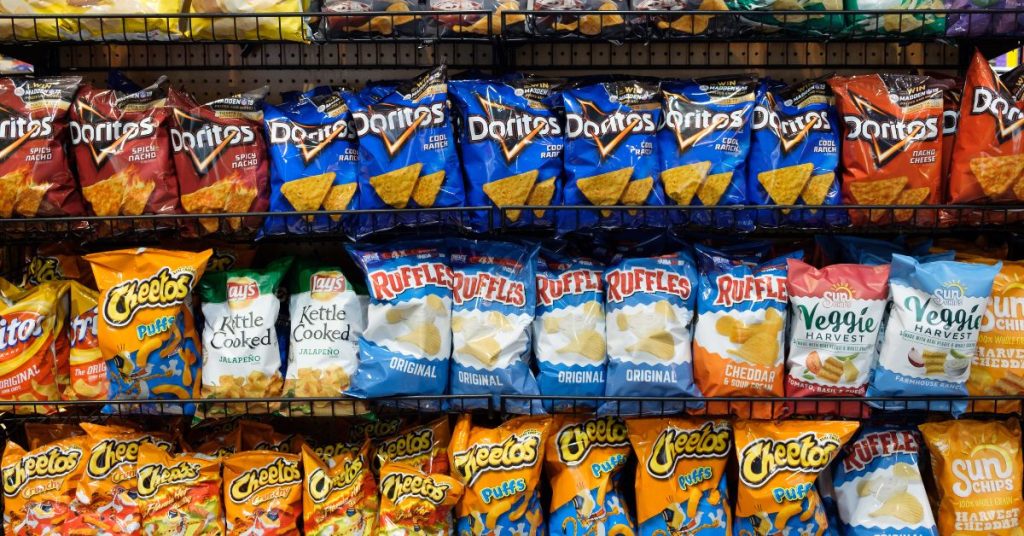

US food products contain thousands of additives. On the one hand, these additives facilitate centralized, industrial food production and increase food company profits by extending shelf life and improving the taste and appearance of food; they often appear in animal products, refined carbohydrates, and other products high in fat, salt, or sugar. However, they also degrade human health or have the potential to do so. That’s why many of the additives used in the US are banned in other countries.
This article, based on my book Sustainable Food Production and Diet, summarizes how weak US regulations allow extensive additive use and gives a few examples of widely used additives. One of the most effective ways to minimize your consumption of these additives is to adopt a dietary lifestyle that minimizes processed foods, such as the whole food, plant-based (WFPB) lifestyle.
Food additives include many artificial and natural flavors, artificial dyes, flavor enhancers, preservatives, fungicides, fruit and vegetable coatings, sweeteners, stabilizers, solvents, dispersing agents, and nutrients. Because of concerns about their potential association with various health problems, food additives must be proven safe before use in Europe. However, this is frequently not the case in the US.
An extensive 74-page report published in 2010 by the U.S. Government Accountability Office (GAO) highlights numerous ways in which FDA regulations have failed to protect public health from food additives.[1] Under FDA regulations, food companies can unilaterally assign generally recognized as safe (GRAS) status to many additives. Once a company assigns this status, it can use additives freely without regulation. Companies often are not required to inform the FDA that they have developed new food additives and assigned GRAS status to them, and the FDA does not monitor whether companies are appropriately assigning GRAS status.
Although the FDA is supposed to amend or revoke GRAS status if emerging science shows that an additive is harmful, there are several flaws in this policy: First, most obviously, if a company has not voluntarily notified the FDA of a new additive, the regulators cannot effectively keep track of the relevant research about that substance. Second, the FDA has limited resources that make it difficult for them to monitor every one of the many thousands of additives in the food supply. And third, while awaiting potential evidence of harm, consumers are exposed to these substances, perhaps for many years or even decades.
The GAO report found that the FDA has not used new scientific information to systematically reconsider GRAS status since the 1980s. It also cited 11 citizen petitions submitted to the FDA between 2004 and 2008, only one of which has been addressed by the FDA.
The report includes several recommendations to improve the FDA’s oversight of food additives, some of which have been at least partly implemented. For instance, the GAO recommended that “the Commissioner of FDA should develop a strategy to minimize the potential for conflicts of interest in companies’ GRAS determinations.” Twelve years later, the FDA finalized a guidance document titled Best Practices for Convening a GRAS Panel, which includes guidance related to potential conflicts of interest. However, because the FDA has “decided not to require information in GRAS notices regarding expert panelists’ independence,” there is no way to ensure companies are implementing their so-called bias-reducing measures. Other recommendations were ignored, including this:
“The Commissioner of FDA should develop a strategy to require any company that conducts a GRAS determination to provide FDA with basic information [. . .] to allow for adequate oversight [. . .] such as the substance’s identity and intended uses, and to incorporate such information into relevant agency databases.”
This is a simple and obviously sensible recommendation. Without even this basic level of transparency, the FDA’s ability to regulate food additives with GRAS status will, by design, remain toothless. This situation illustrates the great extent to which business controls the government in the US. Many citizens would probably find the system unbelievably flawed and as useless as self-regulated traffic laws.
Even when safety testing of food additives is required, such as when GRAS status is not assigned, the FDA often relies on testing that was conducted, funded, or influenced by the companies making the additives. This system is obviously unsuitable for determining public safety or use, given companies have a strong financial incentive to find their products safe when no immediate or obvious negative impacts are evident and no cost-effective alternatives are available.
Beyond relying on biased company testing, food additive safety testing fails to protect public safety in several other ways. For example, additives are often not tested for allergic reactions, hormone disruption, and impacts on children. Perhaps most importantly, food additives are virtually always tested in isolation despite citizens rarely being exposed to only one food additive at a time. Food additives that cause little or no harm in isolation could cause substantial harm when combined with other additives. The typical US diet can expose people to countless combinations, none of which have been safety tested, of food additives per day.

Here are a few of the most commonly used additives and additive categories:
Aspartame
Aspartame is a controversial but widely used artificial sweetener sold under brand names including NutraSweet, Equal, and Canderel. It is used in over 6,000 products, including soft drinks, chewing gum, and diet foods. It is also one of the most common additives from which consumers have reported feeling negative symptoms: following the Freedom of Information Act in 1995, the FDA released a list of 92 aspartame symptoms compiled from over 10,000 consumer complaints.[2] It was responsible for 75 percent of consumer complaints to the FDA!
The history of aspartame’s regulation—or lack of regulation—again illustrates corporate America’s inappropriate relationship with the government. The FDA first approved aspartame for some uses in 1974.[3] However, because many studies showed that it caused seizures and brain tumors in laboratory animals, there was much controversy about its approval; in 1980, a public board of inquiry appointed by the FDA revoked the 1974 approval, concluding that more studies were needed to prove its safety.[2][4] A year later, a newly appointed FDA Commissioner overrode the board of inquiry recommendation and approved aspartame. The commissioner shortly afterward left the FDA and took a job with the primary public relations firm servicing the manufacturer of aspartame.
(Learn more about aspartame: Aspartame—Friend or Foe? Here’s What the Research Says)
High-Fructose Corn Syrup (HFCS)
High-fructose corn syrup is pervasive in the food supply and a common subject of headlines. It is used in the sweet foods you might expect, such as cookies and sodas, but also in many other foods, including breads, condiments, and pasta sauces. US citizens have consumed, on average, between 37 and 63 pounds of HFCS per person annually since 2000.[5] Several studies have found that HFCS contributes substantially to obesity, type 2 diabetes, and numerous other poor health outcomes; even in the absence of weight gain, it can cause metabolic changes.[6]
(What about fructose-containing foods like fruit? Is Fruit Healthy?)
Sodium Nitrate
Sodium nitrate is added to most packaged meat products in the US, including bacon, ham, pepperoni, hot dogs, and lunch meats. It is a preservative that adds a red color that can keep packaged meats, which tend to turn gray quickly, looking fresh for months.[7]
When sodium nitrate is mixed with saliva and digestive enzymes in the human body, cancer-causing compounds called nitrosamines are formed. These carcinogens have been used to induce cancer in laboratory animals, and they are associated with several human cancers.[8]
Excessive sodium nitrate consumption from preserved meats should not be confused with the consumption of natural nitrates from whole vegetables like spinach, celery, and cabbage that contain a natural balance of nutrients and nutrient-like substances.[9] When you consume dietary nitrate in plants packaged with phytochemicals and antioxidants, the body, instead of creating dangerous nitrosamines, produces nitric oxide (NO), a critical molecule for blood vessel health (among other things). Incidentally, “supplements that increase [NO] in the body make up one of the most popular supplement categories today,” but why opt for unproven supplements when you can go straight to a natural source?[10]

Other Preservatives
Other preservatives, such as butylated hydroxyanisole (BHA) and butylated hydroxytoluene (BHT), are used to preserve many different foods and beverages: meats, fats, breakfast cereals, nuts, dehydrated foods, flavorings, desserts, and beer. As antioxidants, BHA and BHT slow the natural breakdown that occurs after foods are exposed to oxygen.[11] Although the FDA considers these preservatives safe up to a certain amount, evidence of long-term safety is insubstantial.[12]
According to the US Department of Health and Human Services (HHS) 2021 report on carcinogens (the 15th report of its kind), BHA is “reasonably anticipated to be a human carcinogen” based on experimental animal studies.[13]
Natural and Artificial Flavors
Because ultraprocessed foods represent about 70 percent of the US food supply and food processing often destroys the natural flavors of food, it is necessary to add flavors back in.[14] This includes so-called natural flavors, the fourth most common item listed on ingredient labels.[15]
Although the FDA does have a longstanding informal policy of what constitutes natural, it has never created rules based on a formal definition.[16] “Without a legally binding Natural regulation,” writes Matthew Goodman in the Food Drug Law Journal, “there has been little opportunity to contest the naturalness of natural flavors in the past.”[15] These flavors, he explains, are often not what consumers might expect, including synthetic chemicals that mimic natural flavors.
Additives Banned in Other Countries but Allowed in the US
We touched on this earlier: many of the additives allowed in the US are either banned or at least more tightly regulated in other countries. According to the book Rich Food, Poor Food by Mira and Jayson Colton, about 80 percent of all convenience foods sold in the US are banned in other countries.[17]
Brominated vegetable oil (BVO) is an apt example. It illustrates why several topics introduced in this article are of enduring importance. Following the Food Additives Amendment to the Federal Food, Drug, and Cosmetic Act (1958), BVO claimed a spot on the very first list of GRAS substances.[18] Remember, these are supposed to be generally recognized as safe. The question is Who recognized BVO as safe and on what basis did they recognize it as safe? It turns out BVO was not so safe.
In 1970, the FDA ended BVO’s 12-year GRAS designation but also determined the risk was not great enough to warrant banning it from the marketplace.[18] How many consumers unwittingly consumed the product up to that point, and how many have consumed it since? Fast forward several decades, throughout which time BVO has been widely used in numerous popular beverages: on November 2, 2023, following recent studies, the FDA proposed to stop allowing BVO use.
While it’s plausible that the evidence indicating potential harm was not unimpeachable before last year, allowing substances to be used while waiting for that evidence is a backward approach. Why not demand food and beverage manufacturers prove safety first? Is a more cautious approach impractical? Surely not. BVO has been banned for over three decades in India and over five decades in the UK.[19] It’s not as if manufacturers haven’t been able to formulate comparable sports drinks without this particular additive to sell in those markets.
It’s likewise plausible that the evidence linking other additives that are banned in other parts of the world (including some discussed above, like BHA and BHT) to harmful outcomes is not as strong as it could be. Other countries are not waiting decades to find out. The difference in the US approach seems to be that regulators are cautious about not getting on the wrong side of the big business, instead of cautiously safeguarding consumers.
Engineered Nanomaterials (ENMs)
ENMs are what they sound like—tiny particles created by humans that do not naturally exist on Earth. Little independent research has been done to determine the impacts of these materials on human health. In Europe and Canada, ENMs must have regulatory approval before being used in food; companies in the US, however, are allowed to unilaterally assign GRAS status to ENMs, leaving regulators and consumers none the wiser.[1]
For example, nano titanium dioxide is used in many supplements and food products. A UCLA study found that it causes genetic damage in mice and promotes cancer development.[20] The International Agency for Research on Cancer lists the substance as a possible carcinogen to humans.[21] But weak GRAS regulations mean we cannot easily determine the volume of nano titanium dioxide and other potentially harmful ENMs in the US food supply.
We should not let our fear of additives distract us from the more substantial failures of the standard American diet. Ultraprocessed foods are unhealthy for a plethora of reasons; so are animal-based foods and beverages. Even if we could remove all of the additives from a sugary breakfast cereal or a strip of beef jerky, they would still be unhealthy.
However, the fact that those foods could not reasonably exist in the marketplace without additives indicates a broader problem: we have become disturbingly removed from natural, optimal dietary patterns. While we should remember that broader dietary patterns are more important determinants of health and disease outcomes than the individual chemicals we eat or avoid eating, we should surely strive to limit our exposure to these additives. When we do that, we naturally move back toward a healthier dietary pattern built on whole plant-based foods.
Copyright 2025 Center for Nutrition Studies. All rights reserved.